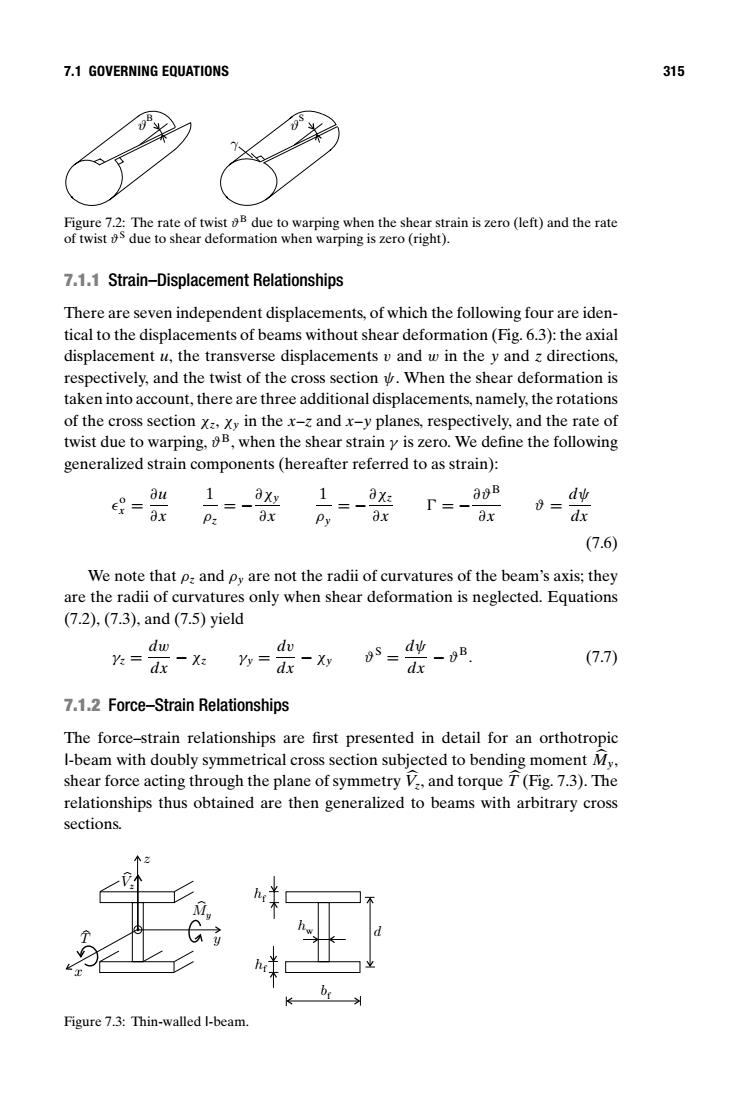正在加载图片...

7.1 GOVERNING EQUATIONS 315 Figure 7.2:The rate of twist due to warping when the shear strain is zero(left)and the rate of twist s due to shear deformation when warping is zero(right). 7.1.1 Strain-Displacement Relationships There are seven independent displacements,of which the following four are iden- tical to the displacements of beams without shear deformation(Fig.6.3):the axial displacement u,the transverse displacements v and w in the y and z directions, respectively,and the twist of the cross section v.When the shear deformation is taken into account,there are three additional displacements,namely,the rotations of the cross section x,xy in the x-z and x-y planes,respectively,and the rate of twist due to warping,B,when the shear strain y is zero.We define the following generalized strain components(hereafter referred to as strain): ou 1=-w 1=-% =- 80B dψ 0= P ax dx (7.6) We note that p:and py are not the radii of curvatures of the beam's axis;they are the radii of curvatures only when shear deformation is neglected.Equations (7.2),(7.3),and(7.5)yield dw dv 收=-X y=衣- dx -9B (7.7) 7.1.2 Force-Strain Relationships The force-strain relationships are first presented in detail for an orthotropic I-beam with doubly symmetrical cross section subjected to bending moment My, shear force acting through the plane of symmetry V,and torque T(Fig.7.3).The relationships thus obtained are then generalized to beams with arbitrary cross sections. Figure 7.3:Thin-walled I-beam.7.1 GOVERNING EQUATIONS 315 γ ϑ S ϑ B Figure 7.2: The rate of twist ϑB due to warping when the shear strain is zero (left) and the rate of twist ϑS due to shear deformation when warping is zero (right). 7.1.1 Strain–Displacement Relationships There are seven independent displacements, of which the following four are identical to the displacements of beams without shear deformation (Fig. 6.3): the axial displacement u, the transverse displacements v and w in the y and z directions, respectively, and the twist of the cross section ψ. When the shear deformation is taken into account, there are three additional displacements, namely, the rotations of the cross section χz, χy in the x–z and x–y planes, respectively, and the rate of twist due to warping, ϑB, when the shear strain γ is zero. We define the following generalized strain components (hereafter referred to as strain): o x = ∂u ∂x 1 ρz = −∂χy ∂x 1 ρy = −∂χz ∂x
= −∂ϑB ∂x ϑ = dψ dx (7.6) We note that ρz and ρy are not the radii of curvatures of the beam’s axis; they are the radii of curvatures only when shear deformation is neglected. Equations (7.2), (7.3), and (7.5) yield γz = dw dx − χz γy = dv dx − χy ϑS = dψ dx − ϑB. (7.7) 7.1.2 Force–Strain Relationships The force–strain relationships are first presented in detail for an orthotropic I-beam with doubly symmetrical cross section subjected to bending moment My, shear force acting through the plane of symmetry V z, and torque T (Fig. 7.3). The relationships thus obtained are then generalized to beams with arbitrary cross sections. hf d bf hf T z y x My Vz hw Figure 7.3: Thin-walled I-beam